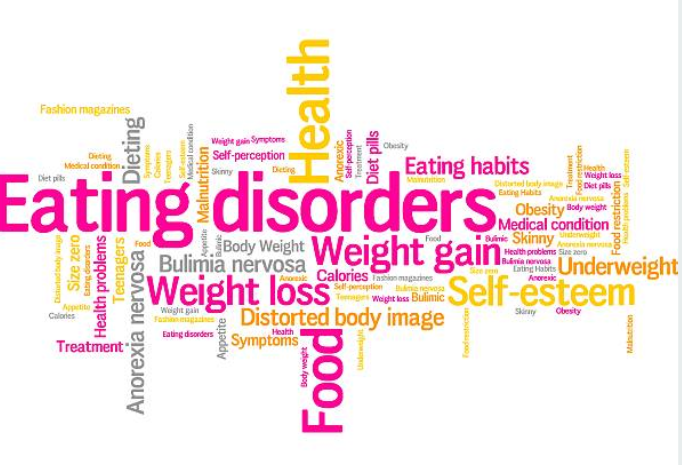Learning
Social Media’s Impact on Eating Disorders and Mental Health
Ever wondered about the impact of social media on our eating habits and mental well-being? We’ve all heard about screen time warnings – how it messes with our sleep and overall health. But does social media mess with our minds and eating habits too?
As technology takes center stage, we often find ourselves captivated by our screens, immersing in a never-ending stream of content. But, what impact do these digital platforms have on us? Are there genuine connections between scrolling and mental health concerns or the complex realm of eating disorders?

In this blog, we will discuss the link between social media and eating disorders as well as mental health. We will also take a look at some tips to minimize your risk of developing an eating disorder or mental health issues due to excessive use of social media.
We will discuss how to take social media breaks, how to be more mindful of your social media usage, and how to engage in positive self-talk. So, let’s get started;
The Link Between Social Media and Eating Disorders
The digital era has brought a new challenge to our society – the link between social media and eating disorders.
Social Media’s Effect on Body Image Perception
Social media platforms, with their constant stream of ‘perfect’ bodies and lives, often contribute to unrealistic beauty standards. Users are exposed to a barrage of images that may manipulate their perception of body image, nudging them towards unhealthy ideals.
The Role of Influencers and Celebrities
Influencers and celebrities hold immense sway on social media. They often promote body ideals that are unrealistic for an average individual. Their airbrushed photos and glamorous lifestyles can create a skewed understanding of what’s attainable and healthy.
Negative Impact on Eating Habits
Social media also introduces users to fad diets and extreme fitness trends, promoting unhealthy behaviors. It’s not uncommon to see posts advocating for drastic calorie restriction or excessive exercise, both of which can lead to disordered eating and a negative relationship with food and body.
Body Shaming and Cyberbullying
Online platforms can sometimes become arenas for body shaming and cyberbullying, further amplifying negative self-image and potentially triggering eating disorders.
Seeking Validation and Likes
The desire for validation and the pursuit of likes and followers can often lead individuals to go to extreme lengths. The race for more and more likes on social media can lead to obsessive behaviors, unhealthy comparisons, and even eating disorders as people strive to maintain an image that is often far from their real selves.
While social media has its benefits, it’s important to recognize its potential drawbacks and to promote healthier, more realistic attitudes towards body image and eating habits.

What’s the Connection Between Social Media and Mental Health
Let’s discuss the surprisingly intricate connections between social media and mental health.
Social Media and Loneliness
Interestingly, despite being a platform for connection, social media can contribute to feelings of isolation. The virtual nature of these connections can sometimes fail to fulfill our innate need for genuine, face-to-face human interaction, leading to a paradoxical sense of loneliness.
Cyberbullying and Its Psychological Effects
Cyberbullying is a dark undercurrent of digital interaction. The anonymity provided by such platforms can often lead to harsh criticisms and personal attacks, which can be detrimental to mental well-being.
FOMO and Social Comparison
The Fear of Missing Out (FOMO) is a byproduct of the endless stream of holiday photos, party updates and professional achievements that flood our feeds. It can lead to a constant feeling of inadequacy and an unending cycle of social comparison.
The Trap of Social Comparison
Social media has created a strange dynamic where likes, shares, and followers are seen as a measure of popularity and validation. This unhealthy quest for digital acceptance often leads to anxiety and low self-esteem.
Impact on Sleep Quality and Mental Rest
Late-night scrolling through social media feeds can disrupt sleep patterns, leading to poor sleep quality. Unhealthy sleep practices can potentially lead to more serious psychological issues.

Tips to Minimize your Risk of Social Media Leading to An Eating Disorder
There are several steps you can take to avoid yourself from the potential harm that social media might have on your mental and physical health.
Allocate Specific Time for Social Media Use
It’s crucial to have a healthy balance. Instead of endlessly scrolling through your feeds, dedicate specific time slots for your social media activity. This ensures you’re not spending excessive amounts of time on these platforms.
Unfollow Accounts That Impact Your Mental Well-being
Don’t hesitate to unfollow or mute accounts that make you feel inadequate or trigger dissatisfaction with your body. It’s your virtual space, make sure it’s a positive one!
Prioritize Spending Time With Friends and Family in Person
While online connections can be delightful, they should never replace real-world interaction. Physical meet-ups, conversations, and shared experiences reinforce our sense of community and belonging.
Participate in Meaningful Conversations and Discussions
Engage with content that sparks thoughtful dialogues and broadens your perspective related to marketing, business or your field, rather than focusing solely on appearance-based content.
Reduce Screen Time for Improved Rest
Your body needs a break from the blue light emitted by screens. Reduced screen time, especially before bed, can lead to better sleep and overall health.
Limit Interruptions During Work or Study Hours
Turn off notifications or use apps to block social media during your productive hours. This helps maintain focus and reduces the stress of constant digital bombardment.
Avoid Comparisons and FOMO (Fear of Missing Out)
Remember that social media is a curated highlight reel of people’s lives. Resist the urge to compare yourself to others and don’t let FOMO guide your actions.
So, utilize these tips to minimize your risk of eating disorder and mental health issues. Also, take some regular breaks from social media to refresh your mind.
FAQ’s
Q: How social media affects body image and mental health?
A: Social media platforms often portray idealized images of beauty and body shape which can lead to unrealistic expectations. These expectations can negatively impact our self-esteem and body satisfaction, contributing to an unhealthy mental state.
Q: Does the media play a role in the development of eating disorders?
A: Yes, media can often contribute to the development of eating disorders. With the constant bombardment of images portraying ‘ideal’ body shapes and sizes, individuals may feel pressured to conform to these standards, potentially leading to unhealthy eating patterns and disorders.
Q: How the media affects body image and eating disorders?
A: Media, particularly social media, can perpetuate unrealistic and harmful beauty standards. These images and messages put a pressure on individuals, especially females. This pressure led to poor body image, mental health issues, eating disorder and unhealthy eating habits.
Conclusion
Social media has a significant impact on our mental health, and unfortunately it isn’t always positive. Eating disorders can be triggered by exposure to triggering images on social media platforms. Thorough awareness of body image issues is needed if we are to properly address this problem.
We must actively engage in healthy behaviors, both online and offline, such as avoiding comparing ourselves to others, challenging negative thoughts, and monitoring our digital media intake. At the end of the day, remember, it’s okay to step away, to disconnect from the virtual world and reconnect with yourself. So, good luck and thanks for reading!
SEE ALSO: 5 Website Maintenance Hacks To Ensure Uninterrupted Online Success

Learning
First-Time Buyer’s Guide to the UK Property Market

Entering the UK property market as a first-time buyer can feel both exciting and daunting. The process is filled with potential pitfalls and complex decisions, but with the right guidance, it can be navigated smoothly. The estate agents in Yorkshire demystify the journey from the initial decision to buy a home to the moment you step over the threshold of your new property.
Understanding Your Financial Position
The first and perhaps most crucial step in the home-buying process is understanding your financial situation. This includes assessing your savings, income, and current debts. Here’s how you can prepare:
1. Deposit: Generally, you’ll need at least 5% of the property price as a deposit, though aiming for 10% or more can provide better mortgage rates.
2. Income and Expenses: Use a budget planner to assess your monthly income against your expenses. This will help you understand how much you can afford in monthly mortgage repayments.
3. Credit Score: Lenders will evaluate your credit score to determine your mortgage eligibility. So it’s important to have a good credit score, and you should work on it if required.
4. Mortgage Options: Speak to a mortgage advisor to understand different types of mortgages, such as fixed-rate, variable-rate, and help-to-buy schemes.
Getting a Mortgage Agreement in Principle
A Mortgage Agreement in Principle (AIP) is a statement from a lender indicating how much they’ll likely lend you. You will be a more attractive buyer with an AIP as it shows sellers you’re serious and financially prepared.
Deciding What You Want
Before you start viewing properties, it’s essential to know what you’re looking for. Consider the following factors:
1. Location: Proximity to work, schools, public transport, and amenities are key. Research neighbourhoods to find the best fit for your lifestyle.
2. Property Type: Decide whether you want a flat, terraced house, semi-detached, or detached property. Each has its pros and cons.
3. Must-Haves: Make a list of non-negotiables, such as the number of bedrooms, garden size, and parking facilities.
4. Future Proofing: Consider your future needs. Are you planning to start a family? Do you need space for a home office?
Starting the Property Search
With a clear idea of what you’re looking for, you can begin your property search. Here are some tips:
1. Use Online Portals: Websites like Rightmove, Zoopla, and OnTheMarket are excellent starting points. Set up alerts to get notified of new listings that meet your criteria.
2. Visit Estate Agents: Register with local estate agents who can provide insights into the market and inform you of new properties before they’re listed online.
3. Attend Viewings: Don’t rush this part. Visit several properties to get a feel for what’s available in your price range.
Making an Offer
Once you find a property you love, it’s time to make an offer. Here’s how to approach it:
1. Research: Check the selling prices of similar properties in the area to gauge a fair offer.
2. Negotiate: Don’t be afraid to negotiate. The starting point is most usually the asking price.
3. Conditions: You might include conditions in your offer, such as the inclusion of certain fixtures or a specific moving date.
The Legal Process
If your offer is accepted, the legal process begins. You’ll need a solicitor or licensed conveyancer to handle the legalities. Here’s what to expect:
1. Conveyancing: This is the legal transfer of property ownership. Your solicitor will handle this, including conducting searches, dealing with the Land Registry, and transferring the funds.
2. Surveys and Inspections: Arrange for a property survey to check for structural issues. There are different types of surveys, from basic condition reports to full structural surveys.
3. Mortgage Finalisation: Once the survey is complete and satisfactory, your mortgage can be finalised.
4. Exchange of Contracts: This is when the sale becomes legally binding. You’ll pay your deposit at this stage.
5. Completion: On the agreed completion date, the remaining money is transferred, and you receive the keys to your new home.
Moving In
Moving day can be hectic, but planning can ease the stress:
1. Hire a Removal Company: Book a reliable removal company well in advance. Discover the best deals by getting quotes from multiple companies.
2. Pack Strategically: Label your boxes by room and keep essential items accessible.
3. Notify Utilities and Change Address: Inform your utility providers of your move date and update your address with banks, the DVLA, and other important institutions.
Settling In
Get settled. Introduce yourself to the neighbours, familiarise yourself with the local area, and really start to make the place your own.
Here are a few final tips:
1. Safety Checks: Make sure that your smoke alarms and carbon monoxide detectors are working, and make sure that you know where the gas and electricity meters are located.
2. Maintenance Plan: Keep a record of the smooth functioning of your new home with a maintenance schedule, complete with regular checks and seasonal tasks.
3. Personal Touches: Add personal touches to make the space feel like home. This can be from putting up family photos or redoing the decoration in your rooms.
Conclusion
Buying your very first home in the UK is most definitely a milestone, difficult and full of challenges but rewarding in the end. Such a philosophy guides you in understanding finances and knowing what you want to achieve from detailed research, and seeking professional advice that confidently helps you navigate the property market. Yes, the journey may have its hurdles, but in the end—owning your own home—the reward will be worth the effort. Welcome to your new chapter!
SEE ALSO: Conquer the Chaos: Hacks to Clean Your Home in Half the Time
Learning
5 Health Benefits of Regular Pedicures

There’s nothing quite like a pedicure to keep your feet looking and feeling their best, but did you know that pedicures do more than simply enhance the appearance of your feet? Many people don’t realize that regular pedicures can come with a wide range of health benefits that can promote the well-being of your feet, so here are some ways that your routine pedicure keeps both your toenails and feet in the best condition possible!
Smoother Skin
One of the biggest misconceptions about pedicures is that they only cater to and look after your toenails. While you’ll definitely be leaving each session with a fresh coat of nail polish, your pedicure can also do wonders for the health of your skin. Aside from trimming and shaping your nails and cuticles, you’ll notice that your nail technician also dedicates a few steps to the skin of your feet.
After inspecting your feet and looking for any issues or imperfections that may need to be addressed, your technician will work on an exfoliating scrub to remove any dead skin cells. This step may also be aided by a foot file, which can be used to buff away any calluses and other problem areas manually.
Softer Skin
After your nail technician addresses all the problem areas of your feet and removes any unwanted dead skin cells, he or she will often massage in a moisturizing product, such as lotion, cream, or butter, to ensure that your skin is properly moisturized. These products contain skin-loving ingredients that will ensure that your feet have everything they need to look and feel their best so that you can walk out of your pedicure with a renewed sense of confidence.
Healthier Nails
After your pedicure session, your nails will not only look better due to the fresh coat of nail polish, but they’ll also be healthier and stronger. This is because your nail technician takes their time to ensure that your nails are properly looked after through steps that include deep cleaning, nail trimming, nail filing, and cuticle care. All of these things work together to prevent issues like ingrown nails from occurring, all the while improving the appearance of your nails.
Increased Blood Circulation
While the specific steps included in your pedicure will depend on the beauty salon, most pedicures will have a massage step somewhere in the mix. One of the often overlooked benefits of these massages is the increased blood circulation, which can deliver more nutrients and oxygen to your feet and nails, promoting their health and appearance. Aside from that, better blood flow means reduced tension and soreness, as well as better distributed heat throughout your body.
Reduced Infections
A significant amount of dirt and bacteria can build up on your feet without you even realizing it, but pedicures can be a great way to prevent these from happening in the first place. The exfoliation step of a pedicure removes dead skin cells as well as all the debris that may have accumulated underneath, and the deep cleaning of your toenails and cuticles also gets rid of any impurities that may have slipped beneath them, which can stop infections from happening.
These are some of the many health benefits that you can look forward to at your next pedicure appointment. However, it’s worth noting that you need to book regular sessions to truly reap all the rewards. This can be difficult, especially when you don’t feel like driving to your nearest nail salon after a long day, but the good news is that you can enjoy the salon experience in the comfort of your own home with a home pedicure service.
Learning
Commercial Boiler Installation Services London

For businesses in the bustling city of London, having a reliable heating system is crucial. Whether you’re opening a new office, expanding your current premises, or simply upgrading an outdated system, commercial boiler installation services for businesses in London are essential to ensure your operations run smoothly and efficiently. Proper installation and maintenance of commercial boilers can make a significant difference in energy efficiency, cost savings, and the overall comfort of your workspace.
The Importance of Professional Installation
When it comes to installing a commercial boiler, professional expertise is paramount. Here’s why:
- Efficiency and Performance: Professional installation ensures that your boiler operates at peak efficiency, reducing energy consumption and lowering utility bills. A well-installed boiler can effectively meet the heating demands of your business without unnecessary energy waste.
- Safety: Commercial boilers are complex systems that require precise installation to operate safely. Professional installers adhere to stringent safety standards and regulations, minimizing the risk of accidents and ensuring the safety of your employees and premises.
- Compliance with Regulations: Commercial properties are subject to various building codes and regulations. Professional installers are well-versed in these requirements and ensure that your boiler system complies with all local laws and standards.
- Longevity and Reliability: Proper installation is critical to the longevity and reliability of your boiler. A professional installation can prevent common issues such as leaks, pressure problems, and system failures, ensuring that your boiler runs smoothly for years to come.
Key Considerations for Commercial Boiler Installation
When planning for a commercial boiler installation, several factors need to be considered:
- Type of Boiler: The type of boiler you choose will depend on your business’s specific needs. Options include gas boilers, oil boilers, and electric boilers, each with its own set of advantages. Consulting with a professional can help you determine the best choice for your business.
- Sizing and Capacity: The boiler’s size and capacity must match the heating demands of your commercial space. An undersized boiler will struggle to meet your needs, while an oversized one will lead to inefficiencies and higher costs.
- Location: The placement of your boiler affects its efficiency and accessibility for maintenance. Professional installers can help you choose the optimal location for your boiler.
- Integration with Existing Systems: If you’re upgrading or replacing an existing boiler, it’s essential to ensure compatibility with your current heating system. Professional installers can seamlessly integrate the new boiler with your existing setup.
Choosing the Right Installation Service

Selecting the right installation service provider is crucial to the success of your boiler installation project. Consider the following when making your choice:
- Experience and Expertise: Look for a provider with a proven track record in commercial boiler installations. Experienced installers can handle the complexities of commercial systems and provide high-quality workmanship.
- Reputation: Check reviews and testimonials from previous clients to gauge the provider’s reliability and customer satisfaction.
- Comprehensive Services: Choose a provider that offers a full range of services, including installation, maintenance, and repair. This ensures that all your boiler needs are met by a single, trusted source.
In London, ROWLEN is a reputable name known for delivering top-notch commercial boiler installation services. Their team of experts is dedicated to providing efficient, safe, and compliant installations tailored to the unique needs of businesses.
Conclusion
Investing in professional commercial boiler installation services for businesses in London is essential for ensuring efficiency, safety, and long-term reliability. By choosing an experienced and reputable service provider like ROWLEN, you can rest assured that your heating system will be installed correctly and maintained to the highest standards. Proper installation not only enhances the performance of your boiler but also contributes to the overall comfort and productivity of your business environment.
SEE ALSO:
-

 News4 years ago
News4 years agoLet’s Know About Ultra High Net Worth Individual
-
Entertainment2 years ago
Mabelle Prior: The Voice of Hope, Resilience, and Diversity Inspiring Generations
-
News11 years ago
Enviromental Groups Tell Mekong Leaders Lao Dam Evaluation Process Flawed
-

 Health4 years ago
Health4 years agoHow Much Ivermectin Should You Take?
-

 Tech3 years ago
Tech3 years agoTop Forex Brokers of 2023: Reviews and Analysis for Successful Trading
-

 Lifestyles3 years ago
Lifestyles3 years agoAries Soulmate Signs
-

 Entertainment3 years ago
Entertainment3 years agoWhat Should I Do If Disney Plus Keeps Logging Me Out of TV?
-

 Health3 years ago
Health3 years agoCan I Buy Ivermectin Without A Prescription in the USA?